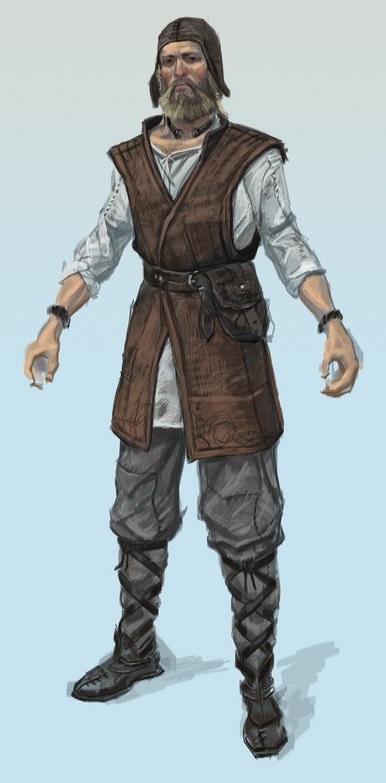Difference between revisions of "Clothing"
Tao alexis (talk | contribs) |
Tao alexis (talk | contribs) |
||
| Line 11: | Line 11: | ||
== Lower Classes == | == Lower Classes == | ||
==== Temperate European ==== | ==== Temperate European ==== | ||
| − | The '''male''' dresses in a short trouser undergarment hanging to the knee, worn without a loincloth. The shirt is loose-fitting and pulled over the head, laced in the upper part. Woolen stocking pants, soft and thick, pull up to the waist; this includes a flap of fabric called a "codpiece" preserves modesty. Overtop the shirt, a doublet — essentially a jacket — is added, with laces that sew the jacket to the hose, holding up the latter. A robe fits across the shoulders and hangs to the knees; the front is worn open, so that the doublet's visible, with the robe tied at the waist. In rough weather, a cloak, with or without a "mantle" (extra cloth over the shoulders) and a hood is worn over the rest. Low boots to the ankles, or high boots to the knees, and a hat | + | The '''male''' dresses in a short trouser undergarment hanging to the knee, worn without a loincloth. The shirt is loose-fitting and pulled over the head, laced in the upper part. Woolen stocking pants, soft and thick, pull up to the waist; this includes a flap of fabric called a "codpiece" preserves modesty. Overtop the shirt, a doublet — essentially a jacket — is added, with laces that sew the jacket to the hose, holding up the latter. A robe fits across the shoulders and hangs to the knees; the front is worn open, so that the doublet's visible, with the robe tied at the waist. In rough weather, a cloak, with or without a "mantle" (extra cloth over the shoulders) and a hood is worn over the rest. Low boots to the ankles, or high boots to the knees, and a durable hat completes the garment. |
| − | |||
| − | |||
Revision as of 21:31, 3 December 2021
Clothing describes a wide range of subjects related to the growing and shearing of fibres, the making of cloth, fashion and regional dress. The amount and type of clothing worn relates to climate, social factors, race and gender; garments cover the body, footwear covers the feet, gloves cover the hands, while hats and headgear cover the head. Jewellery is not generally considered an item of clothing, but play an important role in overall presentation.
This page addresses primarily the subject of everyday wearables that serve as protection from the elements, harsh environments and in labour — those worn by ordinary persons and party adventurers. Descriptions below are not meant to present an accurate scholarly treatison every form of existing Earth customs during the 17th century, but rather to provide some detail for player characters that will ground them in an overview of common dress and habit for different parts of the game world. Specific fashion choices and unique dress items can be provided for players through the equipment list, should such be desired.
Fabrics & Design
Due to a given fabric's weight and properties of insulation, sub-arctic climates prefer a mix of fur and leather for warmth; temperate climates prefer woollens; warm temperate areas and sub-tropics tend towards linen and cotton; while tropical climates will tend towards much less clothing with open woven fibres such as hemp or ramie. Silk is more common in the Far East than anywhere else, though parts of Europe have by the 17th century acquired silk worms and transplanted mulberry trees.
In colder seasons, clothing tends to be layered and pressed tight to the figure, in order to form air pockets inside the clothes that are warmed by the body, serving as insulation. Loose-fitting clothes with less layers predominate in warmer months. However, in extremely hot climates, particularly in the desert where protection against the sun is desperately needed, an inner layer of muslin cotton is adopted so that the body's sweat will produce a continuouosly wet insulation layer between the body and the harsh dry temperature. This is less needed in wet tropical areas, where humidity is high and vegetation growth produces considerable shade; thus in wet tropics, virtual nakedness is practical.
Lower Classes
Temperate European
The male dresses in a short trouser undergarment hanging to the knee, worn without a loincloth. The shirt is loose-fitting and pulled over the head, laced in the upper part. Woolen stocking pants, soft and thick, pull up to the waist; this includes a flap of fabric called a "codpiece" preserves modesty. Overtop the shirt, a doublet — essentially a jacket — is added, with laces that sew the jacket to the hose, holding up the latter. A robe fits across the shoulders and hangs to the knees; the front is worn open, so that the doublet's visible, with the robe tied at the waist. In rough weather, a cloak, with or without a "mantle" (extra cloth over the shoulders) and a hood is worn over the rest. Low boots to the ankles, or high boots to the knees, and a durable hat completes the garment.
